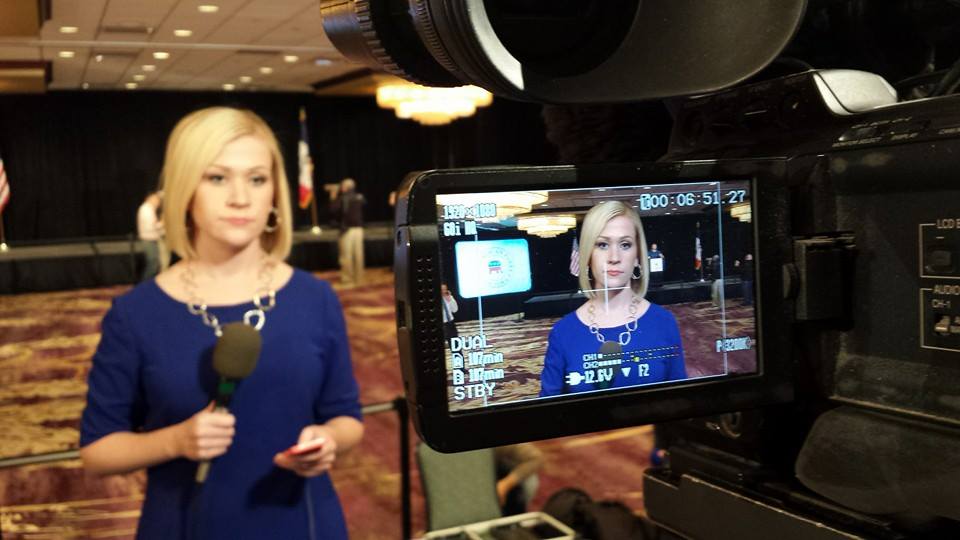There’s a female TV reporter stereotype that America loves to hate.
She wears high heels, is constantly surrounded by a cloud of hairspray and will stop at nothing to break the next big story. She flirts with sources to get the inside scoop. She ruins lives and reputations without fact-checking or batting a heavily false-lashed eye.
But when a video went viral this month of West Virginia TV reporter Tori Yorgey being hit by a car while doing a live shot about a water main break, the country saw a version of a TV reporter they might not have recognized.
A young woman stood alone in the dark, with no camera crew, unprotected and vulnerable. She couldn’t see the danger that was barreling toward her. Yorgey is receiving well-deserved praise for keeping her composure on live TV for WSAZ-TV–an NBC affiliate–after being struck by the SUV. But why was she out there alone in the first place?

I worked as a TV reporter for more than 10 years, and the answer is simple: TV stations created one-man-band reporter positions about 20 years ago to cut costs. If one employee can do the work of two, it saves the station money. Yorgey, who was hit during her last week at the station, was part of an industry that uses and exploits TV reporters like her to get stories for their viewers, often at the expense of their safety and well-being. (Yorgey, a Pennsylvania native, is the new nighttime reporter at WTAE-TV in Pittsburgh.)
I was a multimedia journalist or a “one-man-band” for most of my career. I shot and edited almost all of my stories alone in the field. Often, I’d set up live shots and front them by myself for the evening news, standing in a dark and empty parking lot like the one Tori Yorgey was in.
I never wore high heels; they wouldn’t have survived the days I dragged my camera bag and tripod through the mud for severe weather coverage or the times I sprinted to capture a shot of an alleged criminal being walked into the local jail. Instead of flirting my way through investigations, my routine was white-knuckling the mace I carried in my pocket every time a boss sent me alone to knock on the door of a criminal in hopes of getting an exclusive.
I was chased and screamed at regularly. In the worst neighborhoods, police patrol cars would spot me with my gear and pull up alongside me to tell me it wasn’t safe to be there alone. I would nod and say, “I just need to get one interview.”
I knew I shouldn’t have been in these situations solo, but the consequences of saying “no” to management or coming back to the station empty-handed were overwhelming. Fast-food workers were getting paid more than I was, so I didn’t have a reserve saved up in my bank account to quit. Even if I wanted to leave my job, I was locked into a contract that stipulated I’d have to pay my news station thousands of dollars just to stop working there.
One day, I finally got the guts to push back about being sent to a dangerous neighborhood alone to get a video of flash flooding at 2 a.m. I was called into my boss’s office the following day to be reprimanded and reminded that these situations are “just part of the job” before being sent out of the office to knock on more doors alone.
My experience echoes what many reporters today are up against.

The company that sent Tori Yorgey out alone isn’t small or tight on cash. Gray Television owns the station and will soon become the nation’s second-largest television broadcaster when a deal to purchase additional TV stations is completed. Gray owns stations in 113 cities, and their newscasts reach 36% of US television households.
The company’s chief executive, Hilton Howell Jr., is ironically also the chairman for Bankers Fidelity Life Insurance Company. One could assume he has experience understanding hazards and risks. Yet under this management, Gray continues to place employees in dangerous situations to keep costs low.
Meanwhile, the public’s trust in the local media is falling. A Pew Research Center poll found that while 82% of Americans had at least some trust in the information from local news organizations in 2016, that number fell to 75% in 2021.
Quality journalism isn’t always possible when employees are forced to do it all. I often had to drive hours to get to a story, taking up precious time behind the wheel that would have been better spent making phone calls to sources or researching data. Instead, every day was like an episode of CBS’s “The Amazing Race,” and I was just glad I had something by my deadline. My stories suffered because of it.
When news editors force reporters to “do it all,” viewers aren’t getting access to the quality journalism they deserve. A group of journalists is now calling for safety on the job, and a petition circulating with more than 1,600 signatures is demanding that local TV news ends the practice of solo live shots.
This should be a wake-up call to TV station management and viewers about the reality of a grueling business that has lost sight of its mission to inform and serve the public in a quest to save a buck.
Nikki Davidson is an award-winning freelance journalist who worked as a multimedia reporter for TV stations in New Orleans, Des Moines, Iowa and Greenville, South Carolina.
